SRM-AP All News
ALL News
- Co-edited and authored in the world’s longest-running science journal May 27, 2022
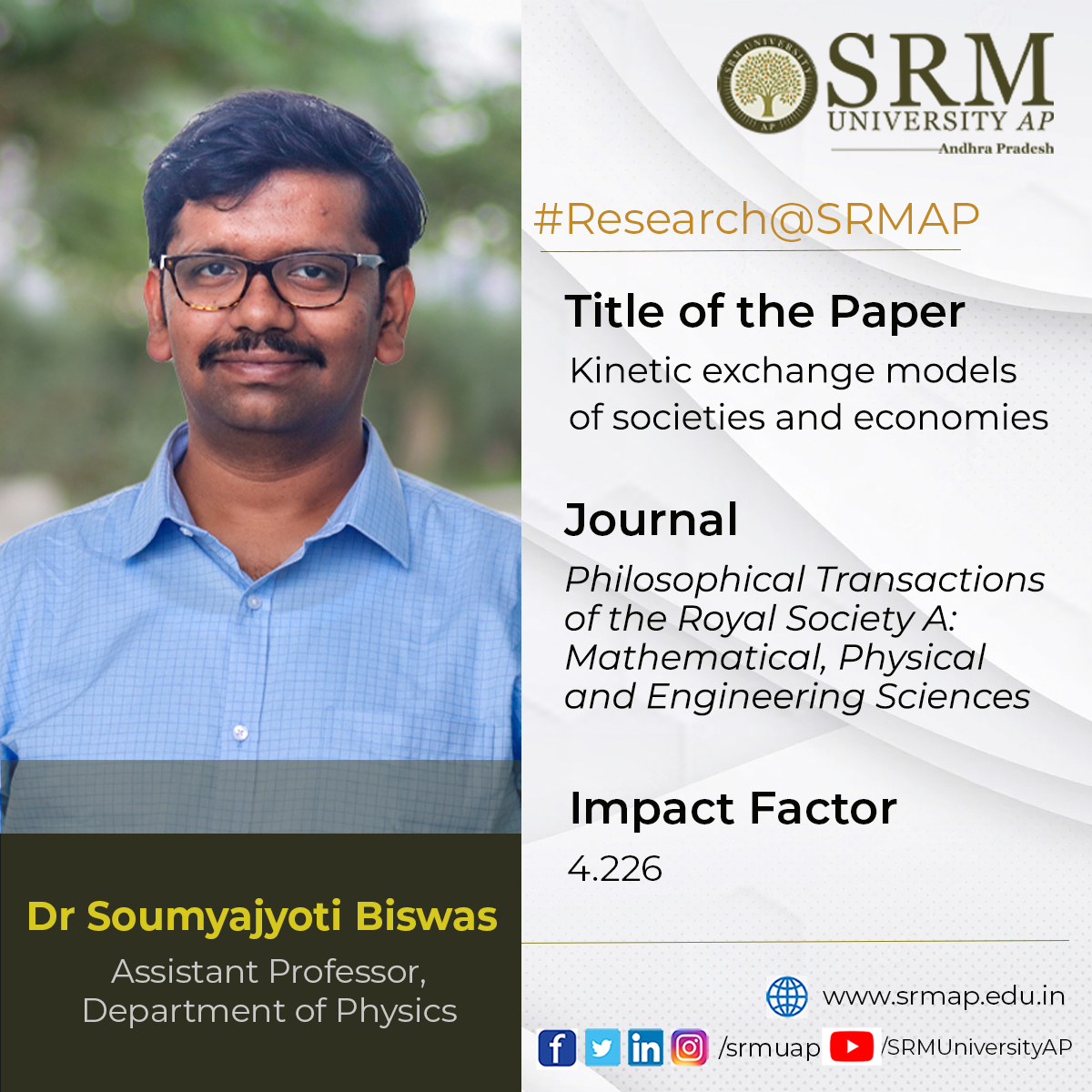
Dr Soumyajyoti Biswas, Assistant Professor, Department of Physics, had two lucky breaks as he got his article “Kinetic Exchange Models of Societies and Economies” featured in the prestigious journal Philosophical Transactions of the Royal Society A, the theme issue co-edited by Dr Biswas himself, along with Dr Guiseppe Toscani from the University of Pavia, and Dr Parongama Sen from the University of Calcutta. Philosophical Transactions of the Royal Society has the prestige of being the world’s longest-running science journal launched in 1665. Publishing high-quality theme issues on topics of current importance and general interest within the physical, mathematical, and engineering sciences, the journal continues its history of influential scientific publishing.
A kinetic model of binary interaction, with conserving or non-conserving exchange, has been an elegant and powerful tool to explain collective phenomena in myriad human interaction-based problems, where an energy consideration for dynamics is generally inaccessible. Nonetheless, in this age of Big Data, seeking empirical regularities emerging out of collective responses is a prominent and essential approach, much like the empirical thermodynamic principles preceding quantitative foundations of statistical mechanics.
Through this theme issue, the authors intend to bring together the current progress in the applications of kinetic exchange models in various applications of societies (opinion formations, rating, social networks, fake news, etc.) and economies (inequality measures, taxation, trade models, behavioral economics, etc.) using numerical simulations, machine learning techniques, analytical methods, and data analysis, reported by physicists, social scientists, mathematicians and economists through some of the original and reviewed articles.
In human interactions, such as a trade (exchange of money) or, discussions or debates (exchange of opinions), following simple dynamical rules, a collection of agents (a society) shows emergent properties that are widely seen in real data (distributions of wealth, formation of consensus, etc.). Without knowing the complexities that are involved at the individual levels, it is, therefore, possible to understand the average properties of the society as a whole. This is reminiscent of simple elastic collisions of ideal gas molecules that give average thermodynamic properties, such as temperature, pressure, etc. without knowing the complexities of the individual atoms. This has been a widely followed route to formulate statistical physical models of societies and economies.
The kinetic exchange models have been a very successful set of tools to understand the socio-economic emergent properties from simple models. Among other things, these models helped understand the growth of economic inequalities, the effects of taxes as well as the spread of opinions. A close quantitative resemblance with real data from various countries of the world demonstrates its usefulness.
The future prospects of the kinetic exchange models for societies and economies include possible predictions of extreme fluctuations in average measurable quantities by looking at the inequality of time series data. The models can help us in identifying the features of the real data that can mirror the underlying extreme fluctuations.
Continue reading → - Evaluating workplace well-being May 27, 2022
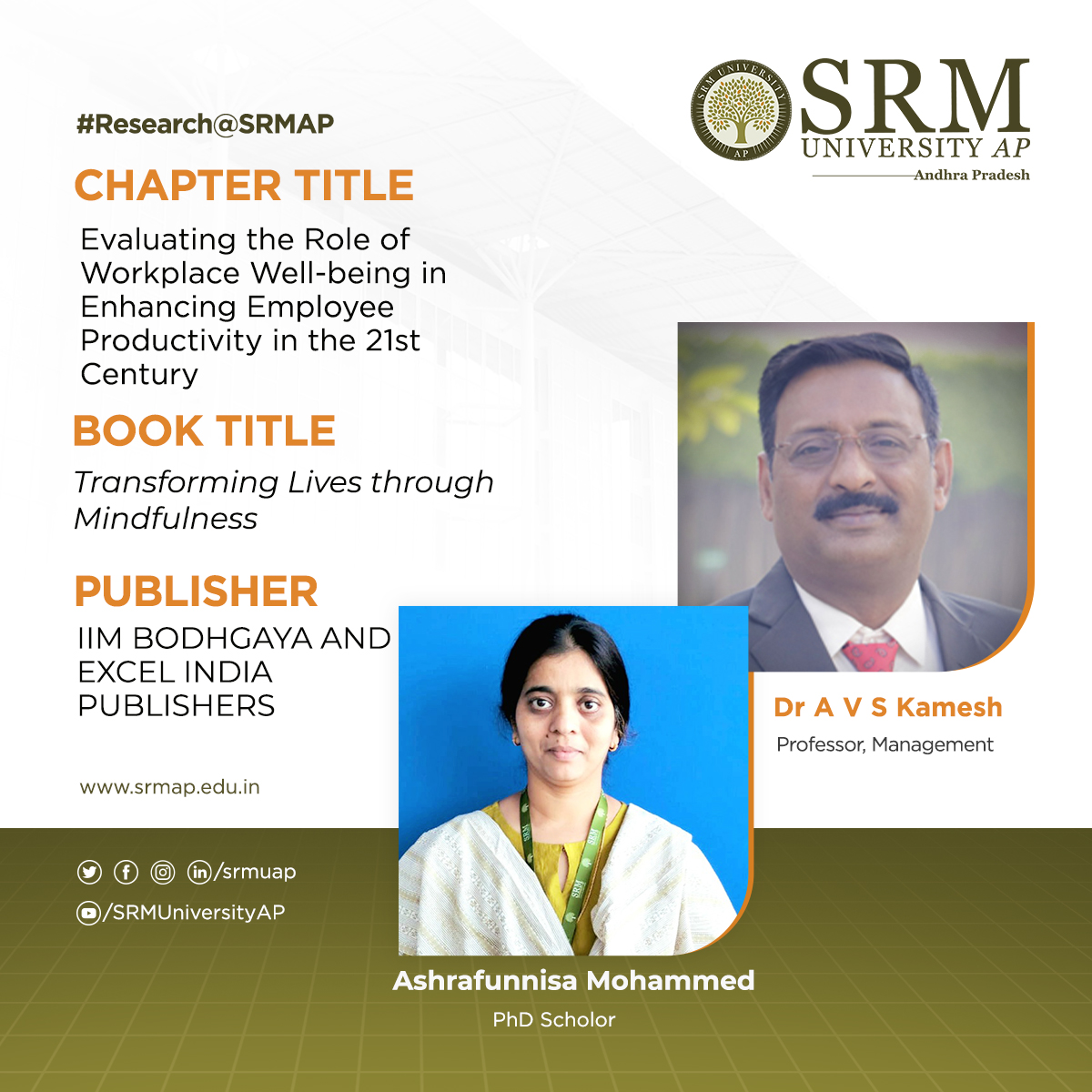
Employee wellbeing and productivity of the organisation are closely interlinked concepts mutually impacting each other in the long run. The idea of workspace wellness and health promotion has been making rounds in recent times, and the outset of the coronavirus pandemic has given added importance to the topic. Having conducted intense study in this regard, Prof AVS Kamesh and his PhD scholar Ms Ashrafunnisa Mohammed from the Department of Management have authored a chapter titled ‘’Evaluating the Role of Workplace Well-Being in Enhancing Employee Productivity in the 21st Century’’, in book Transforming Lives through Mindfulness published by IIM Bodh Gaya AND Excel India Publishers.
Their study tries to evaluate the unique role of workplace well-being in enhancing employee productivity in the 21st century. The contemporary business world is characterised by organisations competing against each other. In a dynamic and complex business environment, the main aim of modern corporate organisations is to retain talented employees by ensuring mindfulness and workplace well-being because these employees are the main sources of competitive advantage from a strategic point of view. Thus, an enhanced level of workplace wellbeing is an effort to create happy and productive workers so that they work optimally and happily. Work is a key social determinant of population health and well-being.
Workplace well-being in India is often focused on changing individual health behaviours through employer wellness programs. The Covid-19 health crisis brought into focus, some of the limitations of present approaches revealing structural conditions that intensify the physical and psychosocial problems of employees and their family members. The onset of the Covid-19 pandemic augured the new dimension of workplace well-being by converting home into a happy place to work. This perspective leads management experts and human resource managers to think about a combined model of work and home as a place of well-being.
This chapter is significant in the times of Post Covid-19 with new perspectives evolving to discuss work-life balance and well-being at workplace which are significantly related to the productivity of the employees. The article mainly targets management educators, corporate managers and personnel managers from public sector companies in India, calling for a comprehensive renovation in the workplace environment.
- Green hydrogen to combat global warming May 26, 2022
‘Energy Conversion & Management’ is a journal that belongs to the top 2% of the “Renewable Energy, Sustainability, and the Environment” subject category. Publishing a paper with an impact factor of 9.7 in such a journal is a considerable achievement. Assistant Professors Dr Sabyasachi Chakrabortty and Dr Mahesh Kumar Ravva and their PhD scholar Ms Mounika Sai Ambati from the Department of Chemistry have accomplished this by publishing a paper titled Photovoltaic/Photo-Electrocatalysis Integration for Green Hydrogen: A review in this Q1 journal.
Abstract of the research
Continue reading →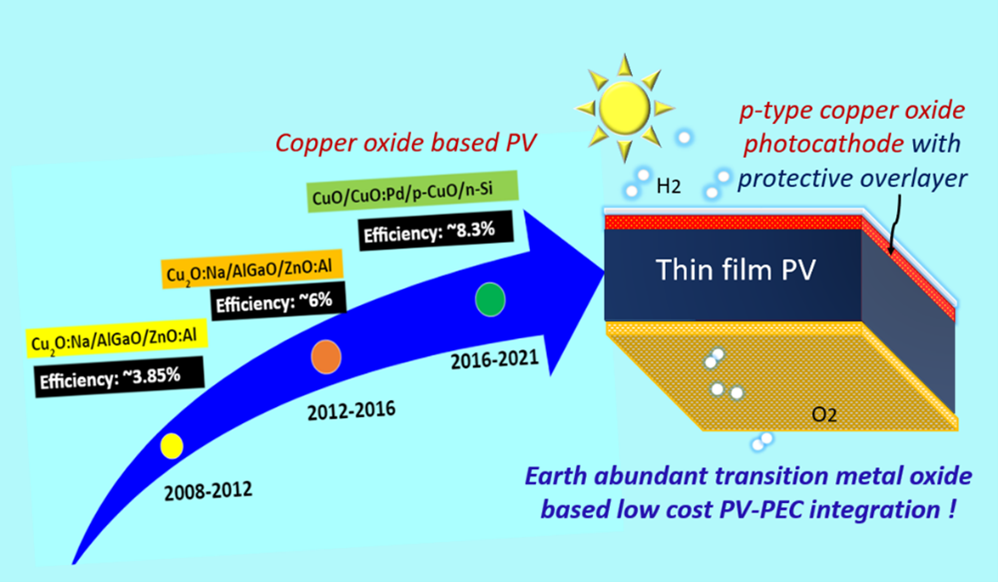 Solar light-driven hydrogen generation via water splitting is essential to combat global warming and CO2 emission. The production of hydrogen from fossil fuels produces massive amounts of CO2. Developing a sustainable and eco-friendly approach to hydrogen production is the need of the hour. Photoelectrochemical water splitting is a clean way to produce hydrogen by using water. The hydrogen generated through water splitting is referred to as Green Hydrogen. Photoelectrochemical water splitting uses metal oxides as photocathode/anode. The challenges that occur here are stability, low efficiency, and large-scale development (reusable electrodes are essential). Hence, the primary goal is to demonstrate photoelectrodes using different metal oxides by in-situ doping of different metals to detect the challenges.
Solar light-driven hydrogen generation via water splitting is essential to combat global warming and CO2 emission. The production of hydrogen from fossil fuels produces massive amounts of CO2. Developing a sustainable and eco-friendly approach to hydrogen production is the need of the hour. Photoelectrochemical water splitting is a clean way to produce hydrogen by using water. The hydrogen generated through water splitting is referred to as Green Hydrogen. Photoelectrochemical water splitting uses metal oxides as photocathode/anode. The challenges that occur here are stability, low efficiency, and large-scale development (reusable electrodes are essential). Hence, the primary goal is to demonstrate photoelectrodes using different metal oxides by in-situ doping of different metals to detect the challenges. - Three patent publications from the Department of CSE May 26, 2022
The Department of Computer Science and Engineering is pleased to announce the publication of three different patent applications from the department. The patent applications were submitted by the BTech students; Mr Kandala Sree Rama Murthy, Ms Padmaja Buggaveeti, Ms Yadlapalli Sai Harshini, Mr Jagruth K, Ms Shikha Chauhan, and Ms Ravi Srihitha under the guidance of Assistant Professor Dr V M Manikandan. They are making the institution proud with their passion and enthusiasm for the research domain.
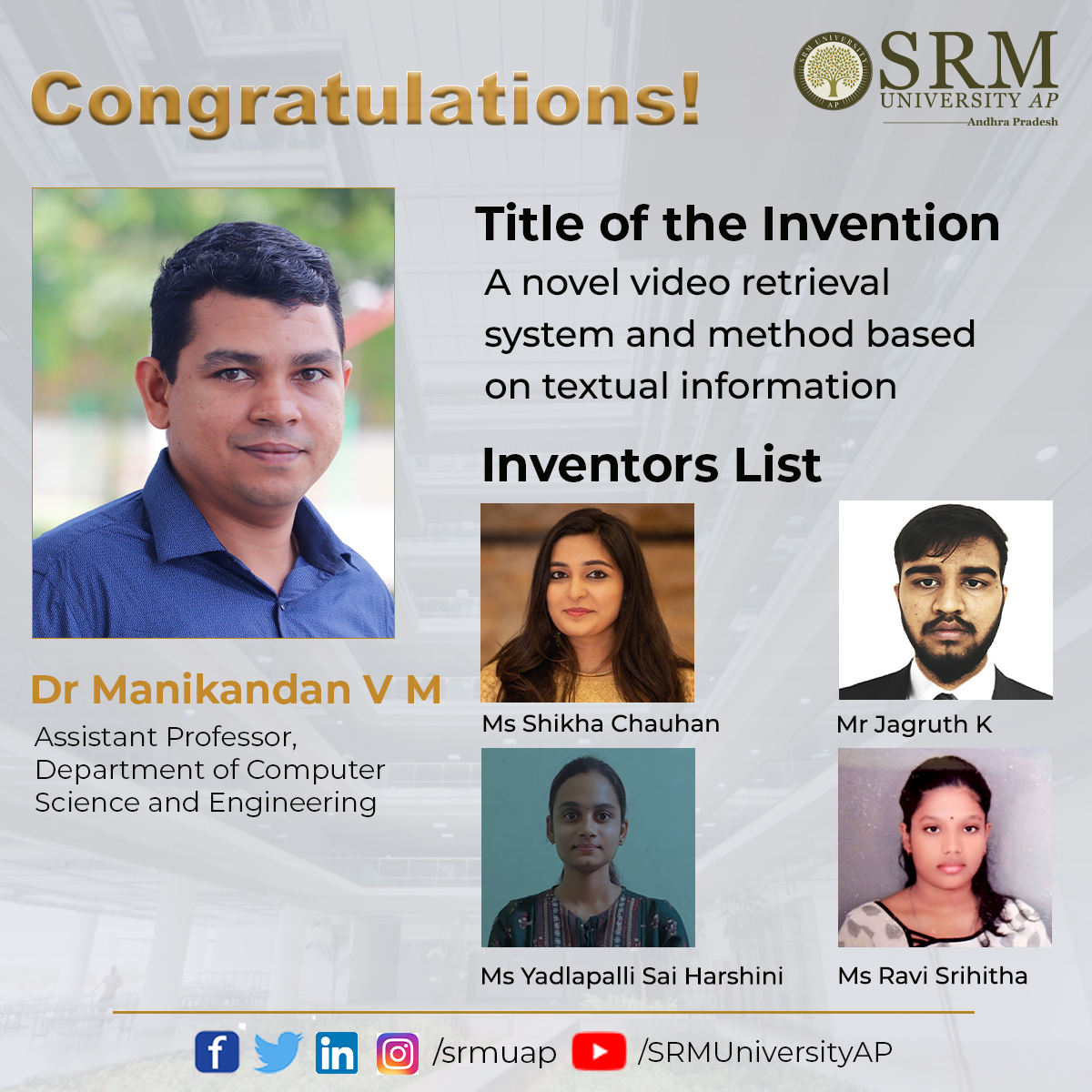 The invention of a new scheme that will help to retrieve relevant videos from a large pool based on the given keyword is an impressive concept with societal relevance. Dr V M Manikandan and BTech students; Ms Yadlapalli Sai Harshini, Mr Jagruth K, Ms Shikha Chauhan, and Ms Ravi Srihitha got their patent application titled A novel video retrieval system and method based on textual information (application number: 202241002653) published.
The invention of a new scheme that will help to retrieve relevant videos from a large pool based on the given keyword is an impressive concept with societal relevance. Dr V M Manikandan and BTech students; Ms Yadlapalli Sai Harshini, Mr Jagruth K, Ms Shikha Chauhan, and Ms Ravi Srihitha got their patent application titled A novel video retrieval system and method based on textual information (application number: 202241002653) published.The conventional video retrieval system uses the metadata to retrieve the appropriate videos. The new scheme processes the video and identifies the text information within the video, which will be compared with the given keyword. They introduced a scene change detection technique to select the frames for further processing in the new system to reduce the overall processing time.
The new scheme will help to retrieve appropriate educational videos from a large video pool based on the given keyword. The processing time is a significant concern in the scheme proposed. The researchers’ future work will be focused on improving the time complexity of the scheme.
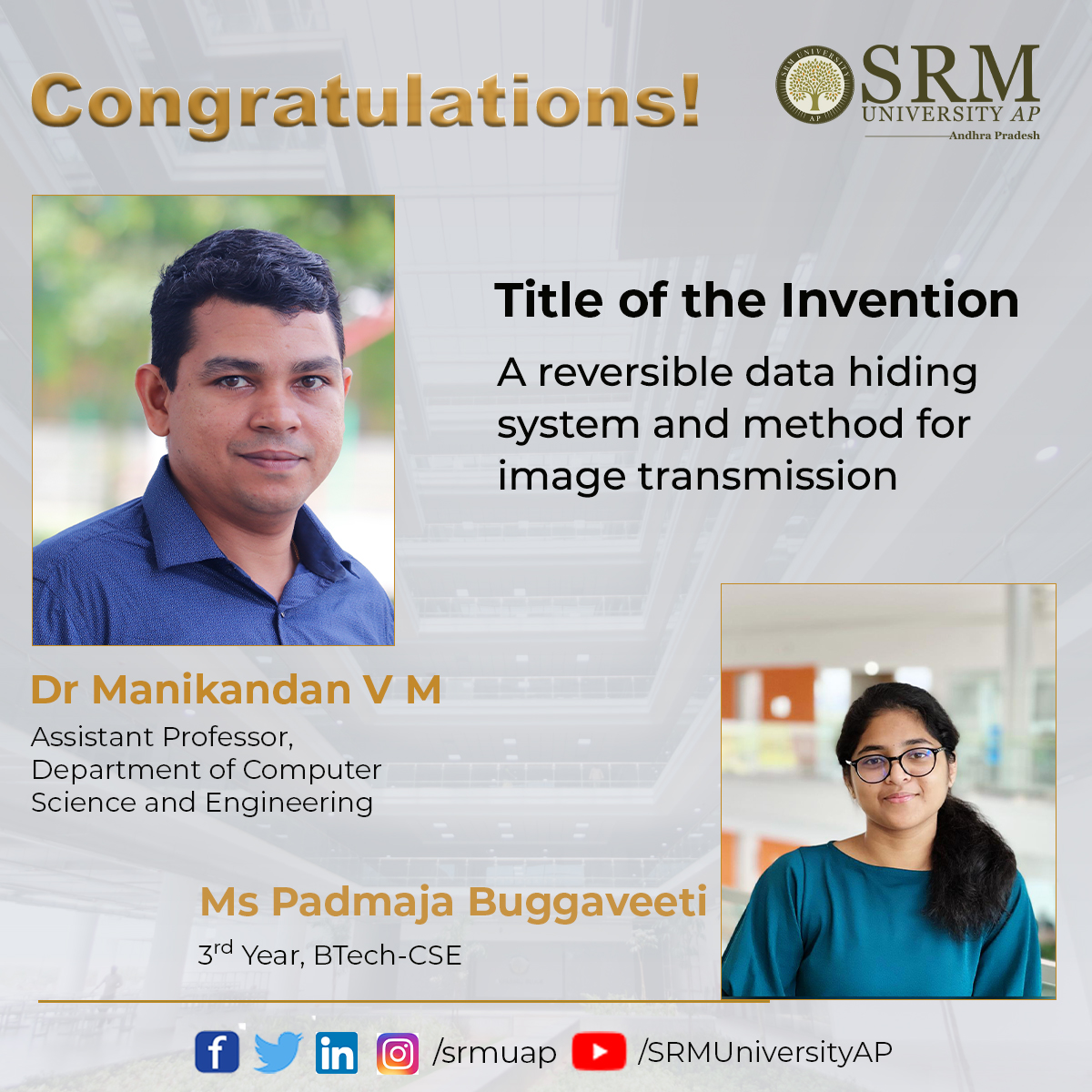 The other research team invented a prediction error histogram shifting-based approach to hide secret messages in a cover image. The patent application submitted by Dr V M Manikandan and Third-year BTech-CSE Student, Ms Padmaja Buggaveeti, is titled A reversible data hiding system and method for image transmission (application number: 202241002654). The method ensures the lossless recovery of the original image during data extraction. The researchers considered the overflow issues in the histogram shifting approach and proposed an efficient method to handle this.
The other research team invented a prediction error histogram shifting-based approach to hide secret messages in a cover image. The patent application submitted by Dr V M Manikandan and Third-year BTech-CSE Student, Ms Padmaja Buggaveeti, is titled A reversible data hiding system and method for image transmission (application number: 202241002654). The method ensures the lossless recovery of the original image during data extraction. The researchers considered the overflow issues in the histogram shifting approach and proposed an efficient method to handle this.Reversible Data Hiding (RDH) provides a way to embed some data in a selected image so that in the future, the hidden data can be extracted along with the recovery of the original image. The new RDH scheme invented by the researchers can be used in the healthcare sector to embed patient reports in medical images, or cloud service providers can use it to embed metadata in the digital data. Their future work will focus on designing and implementing robust reversible data hiding schemes capable of resisting attacks.
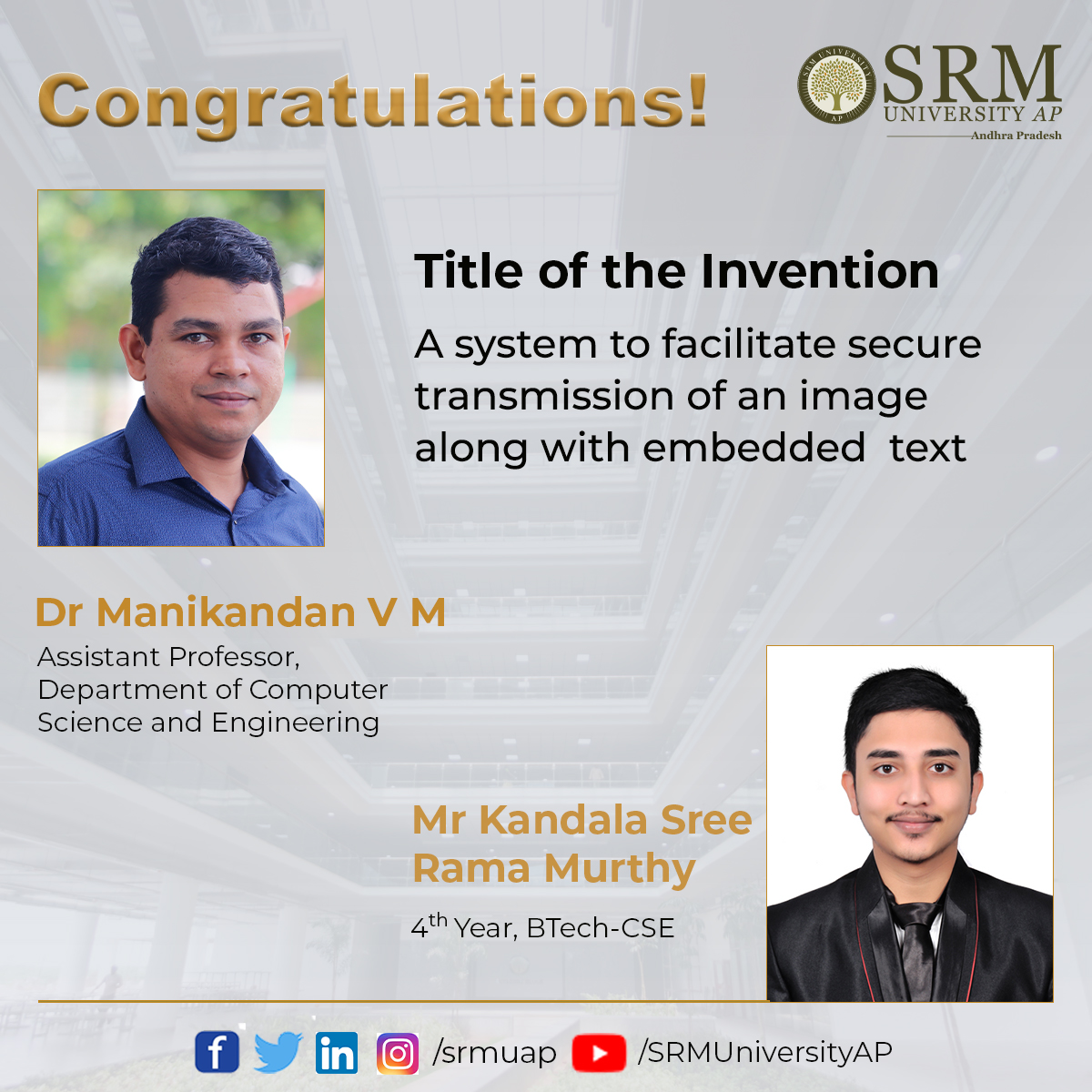 A system to facilitate secure transmission of an image along with embedded text (application number: 202241005221) is the third patent application that got published and was submitted by Dr V M Manikandan and Final year B.Tech-CSE Student Mr Kandala Sree Rama Murthy. The researchers invented a method to embed a message into a selected image during the image encryption process, which provides secure transmission of messages. The receiver will be able to extract the hidden message during decryption. The presented method is useful in medical image transmission to store patient details in the medical image.
A system to facilitate secure transmission of an image along with embedded text (application number: 202241005221) is the third patent application that got published and was submitted by Dr V M Manikandan and Final year B.Tech-CSE Student Mr Kandala Sree Rama Murthy. The researchers invented a method to embed a message into a selected image during the image encryption process, which provides secure transmission of messages. The receiver will be able to extract the hidden message during decryption. The presented method is useful in medical image transmission to store patient details in the medical image.The transmission of medical images and health reports from one hospital to another is widespread in the healthcare sector. Hospitals may want to handle many medical images and health reports every day and ensuring the one-to-one correspondence between them is a tedious task. The invented method will help embed health reports in medical images during encryption. The encrypted medical images (embedded with health reports) can be transmitted securely. The receiver will be able to extract the hidden message after medical image decryption. The researchers’ future work will focus on improving the invented method’s embedding capacity so that lengthy reports can be embedded into the medical images.
Continue reading → - CR&CS endorses MoU with Miraist for Academic Alliance Programme May 26, 2022
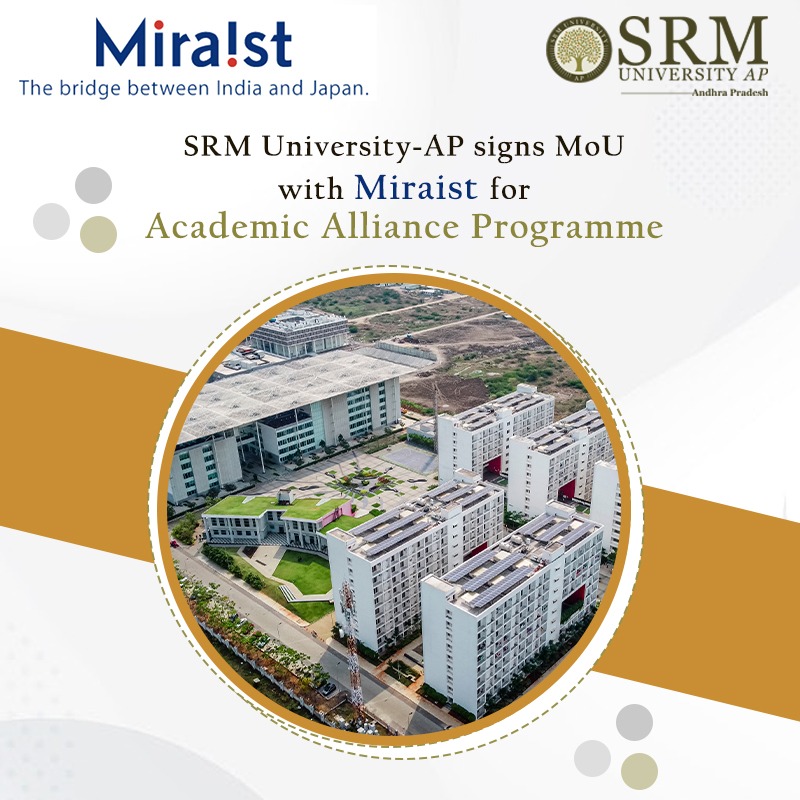
The Department of Corporate Relations & Career Services at SRM University-AP collaborates with Miraist Pvt. Ltd. for the Academic Alliance Program. Under this academic alliance program, the students of SRM University-AP will be offered training in Japanese language and an enviable opportunity to work in Japan.
Miraist is a leading HR recruitment firm in India catering to Japanese industries with end-to-end professional service. This is an excellent opportunity for our students to demonstrate the cutting-edge training they received here in Japanese Industries. Miraist and the Japanese clients will interview the aspiring candidates. Upon receiving the offer, all the successful candidates will be given Japanese training sessions.
Representatives from Miraist Pvt. Ltd. expressed their gratitude to Dr R Premkumar-Registrar, Mr M S Vivekanandan, Associate Director- Corporate Relations & Career Services and Mr P. Venkateswara Rao-Senior Manager, Internship, Corporate Relations & Career Services for making this collaboration possible.
- Dr Divya Chaturvedi steps up her research with SERB-POWER grant May 25, 2022
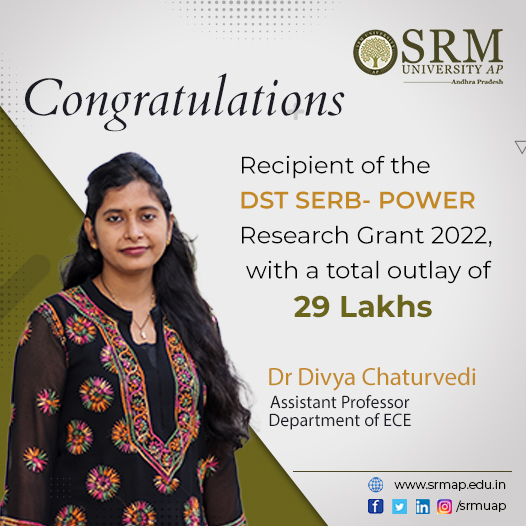
Dr Divya Chaturvedi from the Department of Electronics and Communication Engineering has been awarded the SERB-POWER research grant that amounts to a total of 29 lakhs for a period of three years. The grant was sanctioned for her research titled “Development of Breast Cancer Detecting System Based on Microwave Antenna-Array-Sensors and its Implementation to Internet of Medical Things (IoMT)”.
SERB- POWER (Promoting Opportunities for Women in Exploratory Research) research grants is a scheme initiated by the Government of India with an aim to encourage emerging and eminent women researchers for individual-centric and competitive mode of research funding to undertake R&D activities in frontier areas of science and engineering.
Her study on developing a breast cancer detection system has gained immense attention due to the global increase of the malady in recent decades. It has become the most common cancer diagnosed in women across all age groups. Despite the different tests such as Mammograms, ultrasound, and MRI available to diagnose the disease, there has been little considerable improvement in bringing down the caseload.
Dr Divya’s research intends to develop an advanced detection technique based on Antenna-Array-Sensors and she is attempting to put it into implementation through the Internet of Medical Things (IoMT). Connecting the medical devices to healthcare IT systems through online computer networks will allow the easier and quicker detection of the defect. This may go down as a milestone achievement in the medical domain.
The research grant will help in building better- equipped research lab with the most modern amenities and hiring more manpower to fulfil the project objectives. In the words of Dr Divya, “Better research facilities will aid the faculty in performing various experiments. They will save their travelling time to other universities for accessing research infrastructure. The students can also avail the advantage to intensify their research initiatives”. Through the project she envisions to establish a collaborative dedicated research group that will help in fulfilling the various objectives of the project.
Continue reading → - Tracking the growth of health expenditure in the Middle East May 25, 2022

Middle East countries are characterized by a growing burden of chronic diseases such as diabetes, cancer, cardiovascular diseases, and respiratory diseases in recent times. These are health conditions that require regular access to care in order to lower their morbidity and mortality burden. Hence, healthcare-focused research and development spending has the potential to uncover new methods for the diagnosis and treatment of different health conditions, lower their cost of care, along with reducing morbidity and mortality burden in the population.
Having conducted comprehensive research in this regard, an article titled “Predicting Key Drivers for Health Care Expenditure Growth in the Middle East Region: A Grossman-PLS Modeling Approach” has been published by Dr Shailender Singh and his PhD scholar Mr Muhammad Muazu Bala from the Department of Commerce. It was published in the Journal, ‘Expert Review of Pharmacoeconomics & Outcomes Research’ having an Impact Factor of 2.31. The research was led in collaboration with Dr Nishant Kumar from Amity University, Noida.
The results obtained from the study show that the supply side of care (HSCI) has contributed more than the demand side (SDI) in determining the overall level of health care expenditure of the Middle East countries. This implied that massive investment targeted at achieving high-quality healthcare systems is more noticeable in determining the overall level of health care expenditure. Though progress towards a high-quality health system is a desirable health care goal, particularly for LMICs (Low- and middle-income countries), available evidence shows that expenditure on research and development is quite low.
The study recommends an expansion of health insurance coverage to induce greater utilization of health care services particularly among the aging cohort of the population. The promoters of Universal Health Coverage (UHC) such as the World Health Organization (WHO) and the World Bank have emphasized that obtaining health insurance coverage will induce greater access to health services without facing financial hardships. In line with the findings of this study, since real wage is statistically significant, mandatory employment-based health insurance may induce greater utilization of health services and provide financial risk protection for formal sector employees.
However, this alone will not suffice to achieve greater improvement in health outcomes, especially for LMICs characterized by the largest share of informal sector employment. Thus, other forms of health insurance such as community–based health insurance may help to cover the informal sector and the vast segment of the population that lives in rural areas. Moreover, other pro-poor publicly financed health care payment mechanisms could be a promising path for promoting access to health services and guaranteeing financial risk protection for the poor.

The research infers that health system stakeholders in the Middle East should prioritize exploiting the available resources for strengthening the capacity of their health systems. Also, available data shows that expenditure on research and development is quite low and thus should be considerably increased so that new inventions, innovations, and discoveries could be unleashed for better understanding, treatment, and diagnosis of different health conditions for improving health outcomes.
Abstract of the Research
Initially, this study provides empirical evidence to the Grossman theoretical model using macro-level panel data for 15 countries of the Middle East region from 2000 through 2016. During the second phase, contradistinction analysis is executed and a parallel model of the demand for care as a function of health system capacity indicators is estimated. Lastly, for robustness checks, a new predictive model is developed carrying forward the outcome from Grossman and the parallel models. A variance-based partial least square structural equation modeling (PLS-SEM) is applied to analyse the interaction between health expenditure and the latent construct: socio-demographic factor and health system capacity. Results elucidate that the relative wage rate and the ageing variables are the only indicators that are statistically significant with theoretically consistent signs as postulated by Grossman’s theoretical model. The exact opposite is true with schooling and the proxy of the medical care relative prices. However, in the parallel model, all the four drivers of the demand for care are statistically significant with robust standard errors. Therefore, the Middle East’s data has comparatively a better fit in the parallel model than it does in the Grossman model. Also, the integrated estimation model supports the results of the separate models.
- Top 3 winners of the ‘Pitch and Win’ contest May 24, 2022
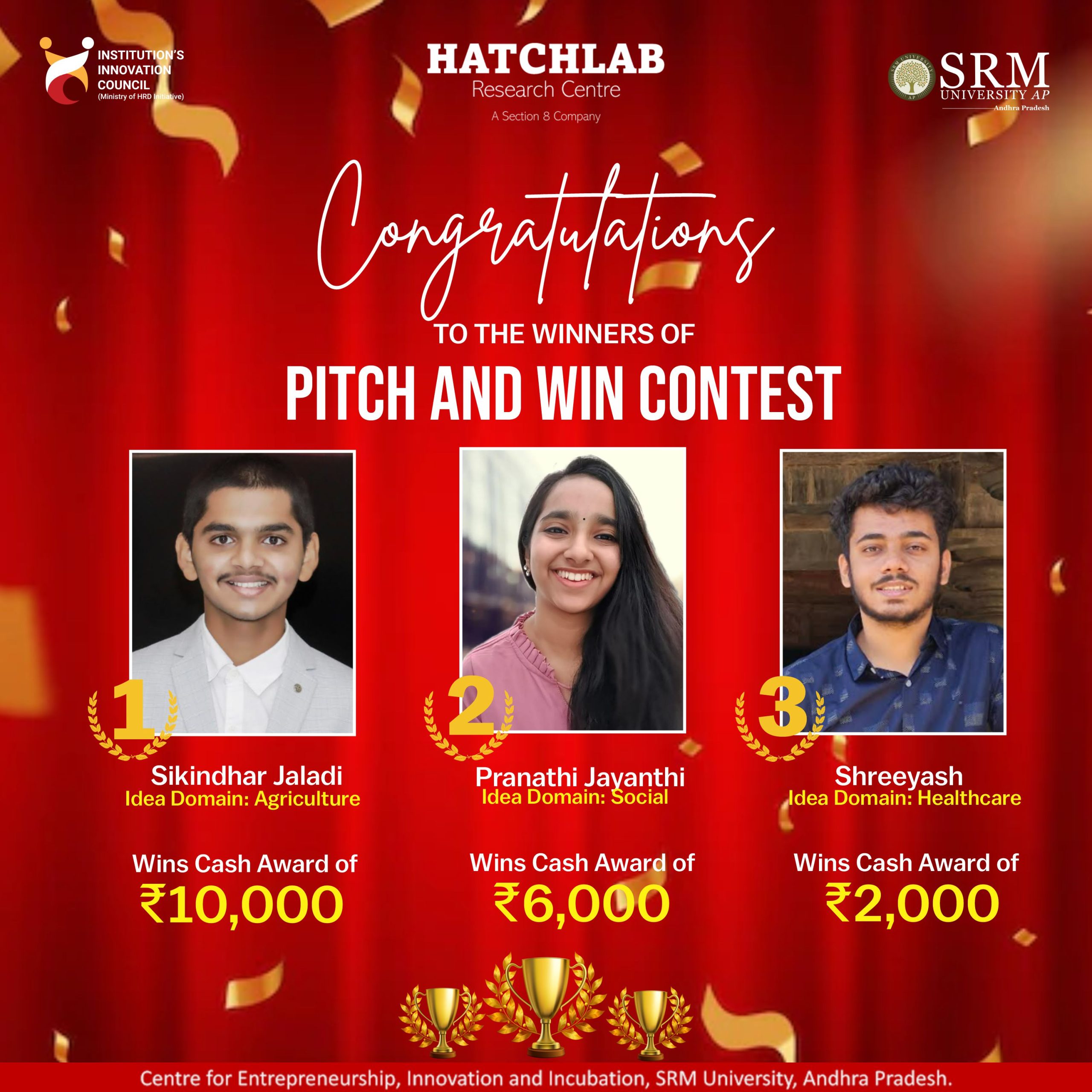 Solving the problems existing in diverse domains through innovative ideas is something only certain people will be able to do. Earlier this year, the Department of Entrepreneurship and Innovation held a Pitch and Win contest, which invited ideas to solve problems across the six major domains. Sikindhar Jaladi, Pranathi Jayanthi, and Shreeyash made it to the top three with their excellent competitive skills and ideas.
Solving the problems existing in diverse domains through innovative ideas is something only certain people will be able to do. Earlier this year, the Department of Entrepreneurship and Innovation held a Pitch and Win contest, which invited ideas to solve problems across the six major domains. Sikindhar Jaladi, Pranathi Jayanthi, and Shreeyash made it to the top three with their excellent competitive skills and ideas.The domains from which the applications were invited included Education, Deep-Tech, Social, Health, Alternate Energy, Retail, Fintech and so on. The top three winners were selected from hundreds of contestants. Also, top 10 applications are selected to be incubated at the Hatchlab Research Centre. They will be nurtured for a period of 18 months and transformed from an idea to a prototype. This will again be developed into a complete product with industrial exposure and corporate mentorship along with seed funding of Rs. 500000 (to the eligible ventures) from the university. A cubical will be allocated to each team to sit and build their products and work on the venture.
Continue reading → - Dr Anu Kuriakose bestowed with CM’s Nava Kerala Research Fellowship May 23, 2022
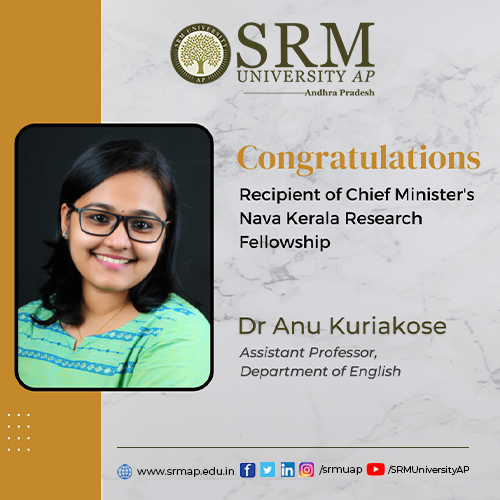
The Government of Kerala has chosen Dr Anu Kuriakose from the Department of English for the prestigious Chief Minister’s Nava Kerala Research Fellowship in the stream of Political Science, Historical Studies, Humanities & Liberal Arts. The award has been designed by Kerala Government to further the state’s development plans by promoting research across various disciplines. Dr Anu obtained the grant for her intriguing study in the domain of gender studies. She intends to look at the digital turn in the genderqueer movements in Kerala with a cross-cultural perspective from any specific locale in Europe.
There have been many research studies involving the examination of queer and trans representation in media. With the turn of the century, we witnessed a remarkable shift in the digital representation of the queer community.
Through her research “Dissenting Heteronormativity and Mainstreaming Identity: A Critical Assessment of the Digital Turn in GenderQueer Movements in Kerala”, Dr Anu is fixated on uncovering the digital collectives in which Malayali genderqueer people are also a part of and the digital turn in the genderqueer movement in Kerala, of late.
She expressed her delight over receiving this opportunity that could help her make substantial contributions to the state’s progress. “I feel proud and humbled for getting this title; my project aims to map the genderqueer movements, the digitally networked associations of which Malayali gender non-conforming people are part, and the nuances of their digital turn at present”, she said.
The Department of English, University of Calicut, has agreed to be a hosting centre for the research project. The GEXcel International Collegium for Advanced Transdisciplinary Gender Studies, Karlstad University Sweden, has also agreed to collaborate. She also wishes to make SRM University-AP a stakeholder in the same.
“I am hugely motivated by the weight SRM University-AP gives to research. From making collaborations to publishing papers in reputed journals and receiving grants from external bodies, the university has anchored as an encouraging platform to stimulate the research pursuits of its faculty and students”, she maintained. “I am truly indebted to my peers and everyone here for providing a conducive environment to fructify my research interests”, remarked Dr Anu.
Continue reading → - Towards green whiskey production May 23, 2022
Dr Karthik Rajendran, Assistant Professor from the Department of Environmental Science, has added another paper to his list of publications. His paper titled Towards green whiskey production: anaerobic digestion of distillery by-products and the effects of pretreatment has been published in the Journal of Cleaner Production (Q1 category) with an impact factor of 9.2.
Abstract of the research
 Using renewable biogas from anaerobic digestion of distillery by-products as a low carbon heat source can decarbonise the distillery process and support the distillery industry for a transition to a more sustainable production process. The study investigated the anaerobic digestion performance of different types of whiskey by-products and the effects of acid pre-treatment on the digestion of solid by-products. Results of biomethane potential assays showed that the methane yield from the unprocessed by-products was 330 mL/g volatile solids (VS) from draff, 495 mL/g VS from thin stillage, and 503 mL/g VS from thick stillage. For the processed by-products, the specific methane yield was 370 mL/g VS from cake maize, 382 mL/g VS from wet distillers’ grains with solubles (WDGS), and 545 mL/g VS from syrup. Acid pre-treatment (1% H2SO4 at 135 ◦C for 15 min) did not significantly improve the methane yield from solid by-products (such as draff and WDGS) but reduced the digestion time by 54.5% for cake maize. The microbial community analysis revealed that methane production from the untreated and acid-pre-treated solid by-products (draff and WDGS) was mainly through the hydrogenotrophic methanogenesis pathway. The gross thermal energy in the form of methane produced from 100 tonnes of mixed unprocessed by-products (draff, thin stillage, and thick stillage) was calculated as 24.4 MWthh equivalents to 60.6% of the thermal energy consumed in whiskey production, which affected the same percentage of CO2 emissions reduction.
Using renewable biogas from anaerobic digestion of distillery by-products as a low carbon heat source can decarbonise the distillery process and support the distillery industry for a transition to a more sustainable production process. The study investigated the anaerobic digestion performance of different types of whiskey by-products and the effects of acid pre-treatment on the digestion of solid by-products. Results of biomethane potential assays showed that the methane yield from the unprocessed by-products was 330 mL/g volatile solids (VS) from draff, 495 mL/g VS from thin stillage, and 503 mL/g VS from thick stillage. For the processed by-products, the specific methane yield was 370 mL/g VS from cake maize, 382 mL/g VS from wet distillers’ grains with solubles (WDGS), and 545 mL/g VS from syrup. Acid pre-treatment (1% H2SO4 at 135 ◦C for 15 min) did not significantly improve the methane yield from solid by-products (such as draff and WDGS) but reduced the digestion time by 54.5% for cake maize. The microbial community analysis revealed that methane production from the untreated and acid-pre-treated solid by-products (draff and WDGS) was mainly through the hydrogenotrophic methanogenesis pathway. The gross thermal energy in the form of methane produced from 100 tonnes of mixed unprocessed by-products (draff, thin stillage, and thick stillage) was calculated as 24.4 MWthh equivalents to 60.6% of the thermal energy consumed in whiskey production, which affected the same percentage of CO2 emissions reduction.Explanation of the research
Many industries meet their energy demand based on the fossil fuels such as coal, oil, and natural gas, which increases carbon dioxide emissions. Alcohol production is one of the heavy fossil fuel using industries, especially in distillation. The waste after alcohol production can be used to produce methane, which can be used as energy in distillation, reducing the need for energy consumption. By consuming the waste and producing energy, up to 60% of thermal energy could be reduced. This also reduces the CO2 emission by 60%. Alcohol industries can use their waste to decarbonise the energy demand, thus meeting the net-zero. India is expected to reach net-zero by 2070, which will be a bigger addition as a part of it.
In this research, Dr Karthik Rajendran has collaborated with Professor Jerry Murphy, UCC, Ireland, and Dr Richen Lin, UCC, Ireland. Applying the similar concept in the Indian context is his future plan for this research.
Continue reading →

